Why CI-CD Pipelines Are Essential for Software Teams and the Business
In modern software development, speed and quality are everything. Customers expect rapid updates, bug fixes, and new features. Businesses expect transparency, predictability, and faster time-to-market..
That’s where CI/CD pipelines come in. They bridge the gap between developers and business stakeholders by ensuring code moves from idea → production smoothly, quickly, and reliably.

Let’s break this down.
Continuous Integration (CI)
Definition: Developers merge their work into the main branch frequently (often several times a day), with automated builds and tests ensuring nothing is broken.
Why it matters
-
Saves countless hours wasted on merge conflicts.
-
Guarantees only stable, working code enters the main branch.
-
Increases confidence in the codebase.
-
Works for both solo developers and teams: you can move faster without sacrificing quality.
Continuous Delivery (CD)
Definition: The practice of always having working software that could be released at any moment. Builds are automated, but releasing to production still requires manual approval.
Why it matters
-
Stakeholders don’t wait months to see progress—they can test working builds weekly or even daily.
-
Teams get early feedback via TestFlight (or similar tools), improving collaboration and alignment.
-
Reduces the cost and risk of releasing since a stable build is always ready.
-
Transparency increases trust between developers, stakeholders, and customers.
Continuous Deployment (CD)
Definition: Going one step further—deploying directly to production automatically whenever tests pass.
Why it matters
-
Rapid delivery of value to customers.
-
Teams can adapt quickly to market changes.
-
Provides a serious competitive advantage.
Key Takeaways from My Experience
Having worked with CI/CD pipelines myself, here’s what I’ve learned:
-
Set it up from day one. It saves time, reduces stress, and improves collaboration.
-
Work in small batches. Fast feedback loops help validate design, requirements, and user experience early.
-
Release often. Even if it’s just a prototype, frequent builds increase trust and transparency.
-
Be transparent. Share progress with stakeholders—they’ll appreciate being part of the process.
-
Promise fast feedback. I often tell clients: “Ask for what you want, and you’ll have a build on your phone the same day to review.”
For me, it’s always better to discover something isn’t working in 2 weeks rather than 3 months.
Over to You
How does your team handle CI/CD?
Do you prefer manual approvals, or are you aiming for full Continuous Deployment?
I’d love to hear your experiences—please share in the comments!